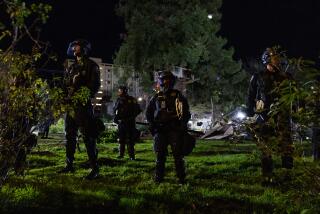PIERCE COLLEGE : Dispute Stalls Use of Kennel Barn
- Share via
A structure built to house dog kennels for the Pierce College animal health technology program sits unused while agriculture department officials and college administrators argue about whether construction is complete.
The pole barn, so named because it consists of a roof supported by wooden poles, “cannot be used as it is,” said Malcolm Sears, agriculture department chairman.
“The pole barn is done . . . with the exception of pouring concrete for the sewer system,” said Dave Bush, building and grounds administrator.
He said that after the sewer system is finished, no more work can be done because the project has already consumed the $15,000 limit allowed by state law.
The state Public Contracts Code requires formal bidding for contracts involving the expenditure of more than $15,000. Such projects must be approved by the Los Angeles Community College District Board of Trustees before going out to competitive bid. This was not done with the Pierce project because it was not expected to exceed $15,000, officials said.
The agriculture department “originally asked for strictly a roof, which would cost less than $11,000, and water, which was already there. Then, things changed and they said they needed a sewer, concrete needed to be removed and the floor sealed,” Bush said.
“‘But I’ve reached my limit. I can’t spend any more money. The plumbing is just about done. The water is there. We cannot provide electricity. There will be one or two lights which will be adequate for safety taking care of the dogs.”
But Sears said unless certain alterations and improvements are made, the 50-foot by 40-foot structure “will just sit there unused.”
“They failed to get it done properly, so now they can’t finish it,” said Lisa Eshman, animal health technology director. Not only that, she said, the barn was reduced to two-thirds its original size and built two feet taller than plans called for.
Bush said agriculture department officials approved the building plans before construction began. “We received their OK that this was what they wanted and needed,” he said.
Sears said the work needed to complete the barn, mainly plumbing and lighting fixtures, would cost $800 to $1,200.
In spite of the $15,000 limit, “the agriculture department feels that philosophically the project can go ahead, because the building is already constructed. We just need to do improvements, such as lighting and plumbing, to a building that already exists,” Sears said.
But Bush insisted that additional work “is not possible. The law is very explicit,” he said.
More to Read
Sign up for Essential California
The most important California stories and recommendations in your inbox every morning.
You may occasionally receive promotional content from the Los Angeles Times.










